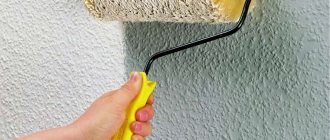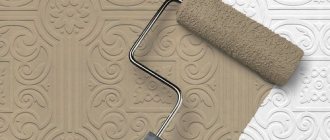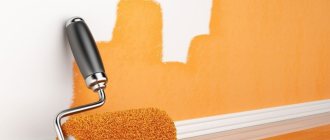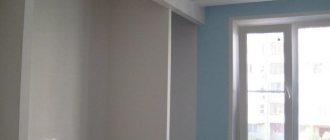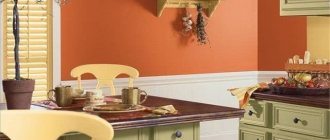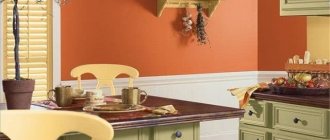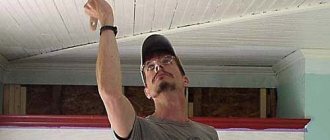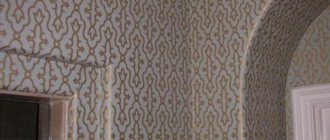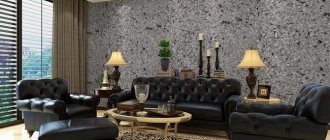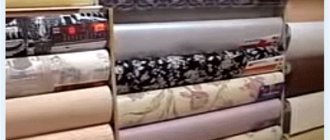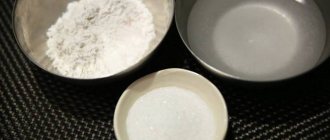Repair is a demanding process with many components. This includes updating furniture, working with interior wall decoration and changing the color scheme of the room. Today's construction technologies make it possible to change the color of a room more often than the number of wallpapers. The solution is non-woven wallpaper. But is it possible to paint non-woven wallpaper, and how often can this be done, what secrets exist? Let's talk about this in more detail.
Specifications
Non-woven wallpaper is made from a combination of cellulose and polymer fibers, representing a non-woven material. They are high density, durable and have a thicker backing than paper. Answering the question, is it possible to paint non-woven wallpaper? The answer is a resounding yes! They are resistant to operational external influences and are excellent for further painting.
Non-woven wallpaper is high-density, durable and has a thicker base than paper.
Types of non-woven wallpaper
Wallpapers come in several types:
- Products made from thickened layers of non-woven fabric. Able to “withstand” up to 10 layers of paint. They differ in texture, very similar to fabric. You can choose products with relief embossing;
- Paper models based on a non-woven layer differ in the variety of patterns and images. Inexpensive and well suited for budget repairs. However, they can only be used in dry rooms (they easily absorb moisture);
- Vinyl-type models are wash-resistant. You can choose products with embossing, gilding, and various prints;
- Fabric. They have a durable non-woven layer and an additional coating of velor and jute.
Vinyl-type models are wash-resistant.
Can they be painted?
Thick non-woven wallpaper is produced especially for painting. They tolerate staining well. For example, acrylic or simple water-based latex paint is suitable. This option is ideal for obtaining pastel colors. If you need bright colors, it is recommended to use acrylic.
Is it possible to paint non-woven wallpaper without painting it with a pattern? Yes. At the same time, you need to make sure that the paint content cannot “soak” the texture and harm the design. How to paint non-woven wallpaper without painting? Painting is carried out in a standard way.
Thick non-woven wallpaper is produced especially for painting.
Conditions for choosing wallpaper for walls with water-based emulsion
Craftsmen do not recommend gluing heavy wallpaper - vinyl panels. They are thick and even special glue will not be able to hold them on a wall previously painted with water-based paint. Non-woven, liquid wallpaper is recommended. The price of paper for a 10 m roll with a width of 0.53 m starts from 345.00 rubles and reaches 1000.00 rubles. The base under them is leveled, stains and uneven coloring are removed. It is better not to purchase wallpaper of different thicknesses. The glue underneath dries at different times, which negatively affects the water-based coating. It is recommended to prepare special bases for this type of panel. They come in two types in rolls: paper base and non-woven material made from modified cellulose. The second type of base is more durable. Under paper and non-woven wallpaper, the adhesive base dries quickly. A non-woven roll of 10 m with a width of 0.53 m costs an average of 1300-1600 rubles.
Liquid wallpaper holds on more tightly than others. The average price per package is from 300 to 1000 rubles, depending on the brand. Packaging consumption per 1 m2 is an average of 3.5-5 m2. In addition, they apply easily to paint and hide surface defects.
But the best option remains non-woven panels for covering walls painted with water-based paint. This is a high quality finishing material, light in weight, with high performance qualities.
When the canvas is already glued, it is not recommended to press it to remove bubbles. They are driven out with a thick roller or a plastic spatula with a rubber tip. If the strip is often torn off, the grip is reduced.
Priming the water-based layer
A water-based emulsion with weak water-repellent properties will peel off if it is over-wetted with glue. The dye will get wet and, along with the new finish, will slide off the wall.
The base is strengthened with a primer. In addition, the adhesion of paintwork materials and the adhesive mixture improves. Fine quartz is introduced into the primer. The astringent components of the primer composition secure it to the base painted with emulsion. The glue clings to the grainy primer surface. In the primer, adhesive elements glue microcracks on the treated wall, thereby strengthening weak areas of the surface. Only after such treatment will it withstand the weight of the glued canvases.
The surface is cleaned of dust and dirt before applying a strengthening primer. The coating is carried out in 2 layers. Each subsequent one is applied to the dried previous one. Manufacturers indicate on the container the time for the coating layer to completely dry. The duration is also affected by air temperature and humidity. A primer composition is selected that interacts with the concrete base. It is recommended to use a white primer, then it will not bleed through the glued panels.
Can I use water-based paint?
Painting non-woven wallpaper with water-based paint is acceptable. Painting non-woven wallpaper with your own hands can be a good construction experiment that will bring many positive emotions. Before painting, it is recommended to read real advice from people and carefully study the instructions from the manufacturer.
Is it possible to paint non-woven wallpaper with water-based paint if a child will live in the room in the future? Yes, but you need to make sure that it is safe and there are no releases of toxic paint elements, and you also need to ensure proper ventilation after painting until it dries completely.
It is necessary to ensure adequate ventilation after painting until it dries completely.
Buying paint - how to choose the right composition for the job?
To paint wallpaper well, when choosing paint, pay attention to factors such as the material of the canvas and the function of the room in the house. Each type of base requires a specific type of paint.
Paper wallpaper can only be painted with water-based paint. For non-woven fabrics, compositions based on water-dispersed components are suitable, and for glass wallpaper, latex or acrylic paint is used. Experts advise applying acrylic, wax or oil-based liquid paste to linkrust wallpaper.
Be sure to consider the type of room. So, acrylic paint is suitable for washable surfaces in the bathroom or kitchen. The surface painted with them is very easy to clean, as a protective film is formed on it. Fabrics on which such compositions are applied will pass and absorb air worse, but they are not afraid of the effects of steam.
In open, brightly lit rooms, latex compounds are used. They do not fade when exposed to UV rays, but they must be handled with extreme care when cleaning. Wallpaper after painting with latex compounds cannot be washed; only dry cleaning is allowed.
When choosing paint, you also need to take into account the degree of light reflection of the coloring composition. Depending on this, experts distinguish between matte, satin, glossy and semi-matte paint.
Satin paints with a moderate sheen are ideal for the bathroom or kitchen. They are characterized by high durability and reliability. Matte compositions perfectly hide defects in walls and ceilings. They also handle excess light well. Glossy paints, on the contrary, visually increase lighting. Experts often paint embossed wallpaper with matte paint to achieve a jacquard effect.
Experts advise beginners to paint wallpaper with water-based paint - it is easy to apply and the most durable. Acrylic compositions are considered the most versatile in use.
To ensure that the painted wallpaper looks exactly the way you plan, test the color intensity of the composition on a control sample before work. If the shade turns out to be too pale, then pigment will need to be added to the composition. Make sure that the amount of pigment in each can of paint is the same.
To prevent the paint from drying out, open the can immediately before work.
The algorithm for the work ahead is quite simple. The ceiling should be painted first, followed by the exposed wallpapered walls, and finally the secondary walls behind the cabinets and sofas. In order not to stain the floor and interior items, they need to be covered with old newspapers.
Painting compounds in open cans dry out fairly quickly. Therefore, you need to open and dilute the paint immediately before applying it.
What paint to paint non-woven wallpaper
If there is special wallpaper for painting, is it possible to paint non-woven wallpaper without painting? Yes. But for this you need to use specialized commercial paint. For example, painting non-woven wallpaper with your own hands should be done with non-toxic materials that do not contain ingredients that can harm the structure of the pattern or wallpaper. Bottom line: is it possible to paint non-woven wallpaper without painting? An affirmative yes!
What paint is suitable for non-woven wallpaper:
- Acrylic;
- Water-based;
- Latex paint.
Do-it-yourself painting of non-woven wallpaper should be done with non-toxic materials.
Preparation of materials and surface
Some experts at the preparation stage advise applying a primer to the canvas to ensure better distribution of paint over the finishing surface and prevent the formation of stains. Typically, paint stains appear due to uneven saturation of the finishing surface. But in this situation, when using special wallpaper and water-based paint, the use of a primer is not a prerequisite. In addition, the finish itself already has high adhesion, which does not need to be increased further.
Related article: How to choose curtains for the living room by style and color
You also need to carry out the following manipulations:
- de-energize the room to prevent short circuits and accidents;
- the temperature regime of the room must meet the requirements of the dye application technology;
- close all windows and doors to prevent the risk of drafts (this will ensure even drying of painted surfaces);
- cover the floor, doors and windows with covering material.
In addition, you will need the following materials:
- different types of rollers for applying the primary layer and patterns;
- tassels;
- tray;
- masking tape;
- ladder.
It would be a good idea to use protective clothing (gloves, hats, goggles) while working.
What wallpaper can be painted
Is it possible to paint non-woven wallpaper? All types of wallpaper can be painted, but since there are several types, you need to approach this issue carefully.
For example, the non-woven layer is only the basis for the outer material. This quality can be woven material coated with gilding, leather, a complex relief pattern made of jute or other material. This kind of wallpaper is not recommended for painting - its appearance is final and is perfectly preserved for many years of use.
It is recommended to paint wallpaper from several sheets of non-woven fabric. They are distinguished by increased fabric density and material thickness (they are initially produced for painting).
Quite often you can find paper wallpaper on a non-woven basis. Such models are varied and beautiful. However, they are not recommended for paint treatment and will be damaged when attempting to paint subsequent repairs.
All types of wallpaper can be painted, but since there are several types, you need to approach this issue carefully.
How to properly prepare the surface for pasting
Without boring our reader too much, we’ll say right away that this approach is allowed, but only if a number of requirements are met, otherwise you can’t expect a long service life of the wallpaper. In this part of the article, we will analyze all the nuances concerning the foundation and look at all the technological stages that we need to go through.
Types of wallpaper
When you come to a hardware store, you will see that there are a large number of varieties of wallpaper presented on the shelves. They can have a different base, differ in thickness, color, and pattern. All this determines not only the appearance, but also the performance, including the ease of gluing. For this reason, it is necessary to correlate these parameters with the characteristics of the base on which they will be glued.
Exposed cement plaster is not suitable for wallpaper
Option #1. Thin wallpaper
Thin wallpapers, which include budget paper, vinyl, expensive silk-screen printing and fabric materials, usually have no more than two layers. Therefore, when gluing, they repeat the surface of the base, and even small irregularities appear through them, which is especially true for smooth models. Preparing the surface for them can take a lot of time, especially when it comes to expensive materials. Such walls and ceilings are puttied at least 4-5 times, achieving perfect smoothness.
If the texture of such wallpaper is embossed, then it may well hide small irregularities, but still you shouldn’t tempt fate, since what is invisible during the work process will definitely catch your eye when redoing something will be problematic. Therefore, we always keep this information in our heads.
Paper wallpaper consists of two layers
Thin wallpaper is much easier to glue, since it is more elastic and does not have much mass. When glued to water-based paint, they will not tighten it too much, that is, damage to its integrity is less likely. The exception is vinyl - this material is poorly saturated, it is inelastic and can tear off pieces of paint when the glue dries.
Option #2. Thick wallpaper
Thick three-layer wallpaper on a non-woven basis can make most minor surface imperfections invisible, so the requirements for the surface on which they are glued are less stringent. By themselves, they are quite heavy, but when gluing they are not impregnated, but only smeared on the wall, so the material does not stretch much, and therefore does not shrink back - the solution is quite suitable for walls painted with water-based emulsion.
Thick non-woven wallpaper
Option #3. Liquid wallpaper
Another type of wallpaper is liquid. This material is a paper paste tinted and diluted in water, which is applied to surfaces in the manner of conventional putty. This wallpaper is the most undemanding to the base, as it fills all the unevenness. Moreover, the more flaws there are on the surface, the better they will hold up, but only within reason. What this means is that material from very deep potholes can crumble over time. However, the evenness of the surface is guaranteed in any case.
Color palette of liquid wallpaper
They can also be glued to water-based emulsion, like other options, but only if certain conditions are met, which we will talk about later.
Application of liquid wallpaper
Prices for different types of wallpaper
Wallpaper
Types of water-based paint
There are several varieties of water-based paints. They have one thing in common - water is used as a solvent, but the base is different, which affects the performance properties.
Option No. 1 Polyvinyacetate based paint
The most inexpensive and low-quality version of water-based paint is made based on polyvinyl acetate (PVA) dispersion. Such a base will have less strength compared to its competitors. Its surface is porous and may peel off in places if applied incorrectly. This paint is applied in two thin layers. It is easily washed off with warm water.
It is better not to glue wallpaper onto a base coated with such paint, although if you are sure that the material will not peel off, you can try. In places where the paint is peeling off, it must be wetted with warm water and cleaned, getting to the strong places.
Polyvinyacetate based paint
Advice! With this approach, you leave different types of bases on the surface. On exposed plaster, the wallpaper may not stick properly and may come off over time. Therefore, it is recommended to first putty the cleaned areas and sand them after drying.
The quality of polyvinia acetate emulsion varies. Good compositions allow wallpapering without the risk of further peeling, while cheap options, naturally, cannot provide such a guarantee. Therefore, our advice is, if you do not know what exactly the walls were painted with, clean off such coating completely. This is not difficult to do, but be prepared for a lot of dirt, so first cover the floors in the room with plastic film.
Option #2. Polymer based paint
If your walls are painted with polymer water-based paint, then you can hang wallpaper on them with more confidence. These compositions include latex, silicone and acrylic paints. All of the options listed are washable, so they do not simply dissolve in water. If you try to scrape them off the surface with a spatula, they will come off in pieces, whereas the PVA-based option will crumble into powder.
A distinctive feature of polymer compositions is their durable surface, which is not afraid of damage and moisture. It is preferable to glue wallpaper onto such surfaces, but only if there are no peelings on it, which can also appear due to improper painting work.
Silicone paint cannot be washed off with water.
Elimination of flaws is carried out in almost the same way - we clean out poorly adhering places with a spatula, level out differences using putty, sand it and you can get to work.
Advice! If you are not sure of the reliability of the polymer water-based emulsion, then to remove it you will need to buy a special remover, after processing which the paint peels off very easily.
Prices for water-based paints
Water-based paint
Surface preparation
Now let's discuss in more detail the process of preparing walls for wallpapering.
We start by inspecting them for cracks, peeling, pockets of mold, and damp spots. All of these points, one way or another, will affect the quality of adhesion to the wallpaper and the strength of the paint itself.
Preparing the walls
If there is mechanical damage, we take a hard spatula and begin to strip the paint to those places where it seems to us that it is already holding firmly. If the paint comes off very easily and in whole layers, as shown in the photo below, then it is best to clean it all off from the base, otherwise you risk ruining the new repair. If this effect is not observed, but doubts still haunt you, then take ordinary tape, stick it to the wall along the cleaned edge and pull sharply. If pieces of paint come off, then cleaning must be continued; if everything is in order, then you don’t have to worry about the fate of the wallpaper.
This is how water-based paint comes off the walls
If you have traces of mold on the paint, this may indicate that your walls are freezing in this area or that moisture is constantly getting on them from somewhere. Perhaps communications are leaking. In any case, the cause will need to be eliminated, otherwise your new wallpaper will soon look no better than the old whitewash.
If mold is found in the corner of the room, then there is a 90% chance that it is freezing. In this case, you should take care of insulation, and it is better to do it outside the room, on the street side. If this is not possible, then you can install a heat insulator from the inside, but usually this will require additional plasterboard covering of the walls... In general, the problem is quite serious, and its solution requires appropriate measures.
The same goes for dampness. It is necessary to find its source and eliminate it. It happens that mold appears on the walls due to poor ventilation of the room. This is the simplest case - here we will check the ventilation, adjust its operation and simply eliminate the fungus. The easiest way to kill mold is with “Whiteness” or any other chlorine-containing composition. The walls are carefully processed, after which the mold disappears literally before our eyes.
Black mold will ruin both your wallpaper and your health.
Prices for deep penetration primer
Deep penetration primer
Before starting any dirty work, you need to vacate the room and lay the floor. If this is not possible, then we move everything to the center of the room and cover it with the same polyethylene or thick fabric.
Furniture is worth protecting
After cleaning, we inspect the walls for unevenness - it is quite possible that crooked walls were painted. If there are such in small quantities, they should be quickly removed with putty - it can only be applied to a strong base, so these places will also have to be cleaned. If there are serious differences in plane, then it may be worth making a decision about plastering the walls, but if the evenness of the finish is not important to you, you can skip this stage.
Correction of irregularities
Next, all cleaned areas must be treated with a primer. Deep penetration acrylic primer is perfect for these purposes. Apply it with a brush and let it dry according to the instructions for use.
Primer of walls
Then we begin to apply putty. Please note that if your walls are painted with polymer vapor-proof paint, for example, latex, then you should choose a putty with similar properties. You can buy it ready-made, in small buckets. The putty is applied in such a layer that it reaches the same level as the paint. Then it is left to dry for 5-6 hours.
After the putty has dried, it must be cleaned until smooth. Use fine abrasive 200-240 for this. Use circular motions to ensure the material is scraped off evenly.
Sanding putty
Having received the repaired surface, you can begin gluing wallpaper. We will describe this process in detail in the next chapter.
Let's give one more piece of advice on how to check the reliability of a base painted with water-based paint. Take a regular newspaper and glue it to the wall with wallpaper glue. After a day, try to remove it. If it comes off without paint and with difficulty, then everything is in order, but if it comes off, leaving behind bald spots, then it is better to clean everything down to the putty.
Video - How to remove paint from walls
How to paint wallpaper with a pattern
The peculiarity of non-woven wallpaper is its varied texture. They can be embossed and have an ornament, images that, when painted, will become clearly visible and form the design features of the room. When painting non-woven wallpaper, several conditions should be taken into account.
It is necessary to use latex or acrylic paints. Is it possible to paint non-woven wallpaper with paint that is not moisture resistant? No. This is why latex paint will look good if you want to apply calm tones. If you need bright colors, it is better to use acrylic. In addition, it is more resistant to washing off.
If you need bright colors, it is better to use acrylic.
Preparing non-woven wallpaper for painting
Direct treatment of wallpaper is carried out after removing contaminants from its surface. Even if the wallpaper was hung just a day ago, you should clean it so that no small particles of dust remain. Is it possible to paint non-woven wallpaper and with what paint was already described earlier in our article.
Direct treatment of wallpaper is carried out after removing contaminants from its surface.
Is it possible to glue
Wallpapering with water-based paint is quite possible, but you just have to prepare the walls first so that the material sticks firmly and does not come off. After gluing, there should be no air, voids, or swelling between the canvas and the surface; the base should be even and smooth.
If the paint is smooth and firmly held on the wall, then simply sand the surface. It should be a little rough, this will improve the adhesion of the material. Additionally, everything is wiped with a damp cloth to avoid dust and dirt.
Required Tools
Paint processing can be done using a standard paint roller. You need to start coloring from the top. Painting in vertical or diagonal stripes from top to bottom.
In addition to the roller, you will need a construction tray and a container of solvent to clean the roller.
Paint processing can be done using a standard paint roller.
Preparatory work on walls covered with water-based emulsion before wallpapering
After testing the strength of the old coating, a method of preparing the walls for gluing is selected:
- the paint is completely washed off from the base;
- without removing the CM, the walls are prepared.
Complete removal of CM
In order to completely wash off the water emulsion you will need: warm water and soft old terry towels. They absorb water well. Towels are soaked generously in water. They wash the walls. The more often the walls are rinsed and wiped, the faster the paint will wash off. If the fabric remains clean after wiping, then the work can be completed. The CM is washed off the wall.
Places where the putty-plaster layer has peeled off need to be repaired. Shallow recesses are puttied, large ones are treated with tile adhesive.
Preparing the wall without removing CM
The existing CM layer is processed with fine-grain sandpaper. Two goals are achieved: the wall is leveled and roughness appears. They improve the tenacity of wallpaper and surfaces. Defects are first sealed, dust is removed with a vacuum cleaner, it is better to wipe everything with a damp cloth. After drying, a deep penetration primer is applied to the wall using a wide brush or roller. After 4 hours, additional treatment is carried out: a mixture of primer and wallpaper glue is applied (component ratio 1:1). Allow 24 hours for final drying.
The wet base is not covered with wallpaper. A simple way to check the degree of dryness. A small cellophane is fixed on it with tape for the whole night. There should be no drops of moisture under it in the morning. If the situation is the opposite, then you need to wait another 24 hours.
Dry walls are ready for wallpapering.
How many times can you repaint
The structure of the canvas is such that the wallpaper can be repainted several times. However, this is not possible in all cases. If there are cracks and scratches, then repainting will not cause problems, but if the wallpaper is old and seriously torn (for example, a wall is exposed), it is better not to repaint.
Moreover, the solvent contained can damage the wallpaper glue and then a deep rupture will occur. In this case, you need to carefully cover the gap with putty, and then reapply the paint.
The structure of the canvas is such that the wallpaper can be repainted several times.
How to paint a surface with your own hands
The process is simple and goes like this:
- Wallpaper to be painted must be well glued and dried.
- The roller must be dipped into the paint so that it evenly saturates it.
- The roller should be rolled slowly so that an even mark without streaks remains.
- It is better to paint hard-to-reach places with a brush manually.
The roller must be dipped into the paint so that it evenly saturates it.
Advice from professionals
The peculiarity of non-woven wallpaper is that you can show some creativity when painting:
- You can paint the wall right before gluing. Then the inner color will come through the wallpaper, creating a pleasant visual effect;
- You can highlight the relief grooves with a short-haired roller, and then manually paint the curls (this, of course, will take a long time, but it will look better);
- Before gluing, you can paint the wallpaper on the reverse side, and after gluing, paint the outer side with a different color - you will get an unusual color mix (mixed colors must be chosen correctly, without creating a visual resonance).
The peculiarity of non-woven wallpaper is that you can show some creativity when painting it.
Non-woven wallpaper is great for decorating rooms - wide rolls cover a room well and quickly, and the possibility of re-painting gives freedom to the painter's imagination. Experiment and you will succeed!
Wallpaper glue
The work can be done efficiently and quickly if you purchase glue for the type of wallpaper.
Experts recommend:
- adhesive composition from the French company Kleo (for non-woven fabric the price is 867.00 rubles per 1 kg. A package of 260 grams is diluted with 6.0 liters of liquid glue, which is used to cover a 30 m2 area), the second option is Quelid (the price depends on the type of wallpaper. For non-woven wallpaper price 309.00 rubles per pack of 300.0 grams. Enough for gluing 4 rolls);
- CMC, proven over the years (price 50-200 rubles). If PVA is introduced into the composition, then the leadership of the mixture in terms of strength is undeniable.
